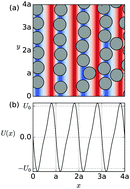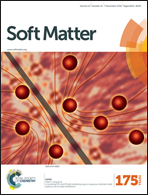Collective ratchet effects and reversals for active matter particles on quasi-one-dimensional asymmetric substrates†
Abstract
Using computer simulations, we study a two-dimensional system of sterically interacting self-mobile run-and-tumble disk-shaped particles with an underlying periodic quasi-one-dimensional asymmetric substrate, and show that a rich variety of collective active ratchet behaviors arise as a function of particle density, activity, substrate period, and the maximum force exerted by the substrate. The net dc drift, or ratchet transport flux, is nonmonotonic since it increases with increased activity but is diminished by the onset of self-clustering of the active particles. Increasing the particle density decreases the ratchet transport flux for shallow substrates but increases the ratchet transport flux for deep substrates due to collective hopping events. At the highest particle densities, the ratchet motion is destroyed by a self-jamming effect. We show that it is possible to realize reversals of the direction of the net dc drift in the deep substrate limit when multiple rows of active particles can be confined in each substrate minimum, permitting emergent particle-like excitations to appear that experience an inverted effective substrate potential. We map out a phase diagram of the forward and reverse ratchet effects as a function of the particle density, activity, and substrate properties.


 Please wait while we load your content...
Please wait while we load your content...